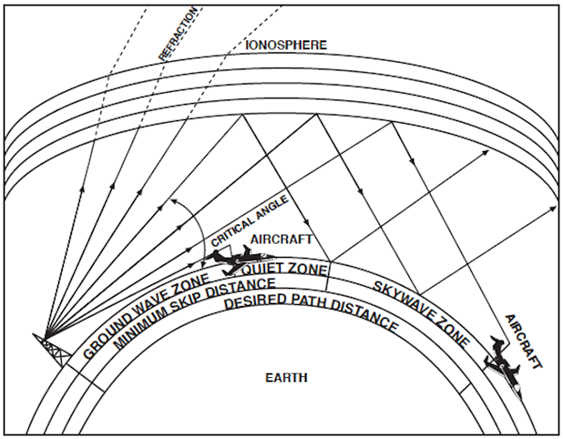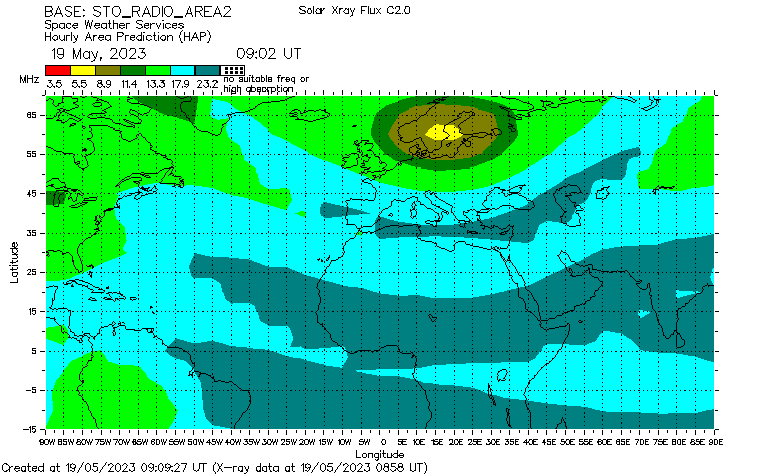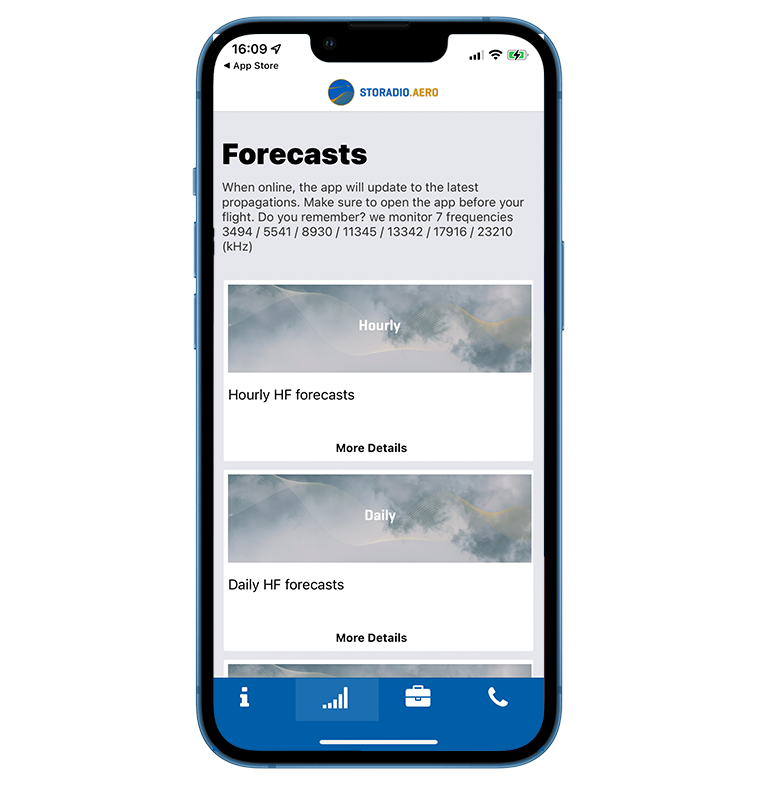
The term ”shortwave radio” covers radio traffic using a waveband of 3 megahertz (MHz) up to 30 MHz, also know as the HF radio (High Frequency) band.
Shortwave is a moniker coming from the length of the radio waves, but this is a bit deceptive since 3 MHz radio transmissions have a wavelength of almost 100 meters, down to 10 meters for 30MHz transmissions. The reason for the name was that in the early days of radio, shortwave did indeed use transmissions with much shorter wavelength than the first developed long and medium wave, which have wavelengths from 100 kilometers down to 1 kilometer.
Modern 4G/5G mobile phones and SATCOM at the other end of the spectrum are down to centimetre wavelengths.
Rules of thumb
In this article about propagation and what frequencies to use, we will cover the good parts to know. We start with rules to remember:
1. The longer the wavelength is, the longer the reach and more widespread the signal will be
But it will also need a very high transmitter power (at the far end counted in 100s of kilowatts, kW) to overcome the absorption from the earth’s surface, on its way to the receiver. The lower frequencies, up to and including HF, also have the ability to “hug” the ground- or ocean surface and literally follow a curved path, supporting spread over long distances (calling for much less power, maybe a few 100 Watts, while we at STORADIO as a station with wider coverage use 3-5 kW).
2. The shorter the wavelength, the shorter the distance it will travel
This is so unless the signal is extremely well focused in the exact direction of the receiver. Those very/ultra-high frequencies only need very low transmitter power (counted in milliwatts, mW) to be usable. The distance limitation is based on how well the signal is focused. This in turn depends on the size of the antenna.
SATCOM is extremely well focused, and the 4G/5G mobile is omnidirectional but instead usually limited to a distance less than a kilometer. The higher the frequency the more it also needs undisturbed direct line of sight.
In the middle of the spectrum both in wavelength and in required transmitter power is the HF band. This band is unique as it is also the only frequency range that normally can use the ionosphere’s blanket of gases as a natural “satellite dish”. The ionosphere’s blanket reflects the HF radio signal back down to earth, and the signal will continue to bounce until it eventually fades out.
Line of sight versus bouncing
VHF signals are of higher frequencies that continue in a straight line, and rather quickly fade out, or simply continue into space.
The HF radio signal can be used both in the direct line of sight and to some distance beyond the horizon (ground wave zone), as well as after bouncing between the ionosphere and the earth one or more times.
One factor to remember when it comes to the radio signals bouncing are the “skip zones”, or ”dead zones”. From the position of the transmitter the signal bounces in the ionosphere at different angles, therefore the receiver position might be between the bounce areas (skywave zones) on the ground. This is the skip zone, and in this area, you won´t receive the radio signal.
One way of countering this is to use another frequency. Doing that, you will allow the radio signal to use a different layer in the ionosphere, so changing the angle a bit and at least altering the skip zone to a slightly different area.
Think of it as a billiard ball bouncing at a certain angle. When you change frequency, you change the angle of which the billiard ball hits the cushion.
If you want more exact details of how HF radio propagation works, we recommend this site: https://www.code7700.com/hf.htm
Propagation of HF radio waves or how they spread across the skies
The reflection properties of HF described above are what makes it work, but it is also what makes HF less predictable.
The physical conditions of the ionosphere change both in some ways very slowly and in other ways very quickly but also dramatically due to different parameters. They include things like the 11-year sunspot circle / summer or winter / night or day / current solar activity from minute to minute (like northern and southern lights) and so on.
There are several layers in the ionosphere that reflect HF waves differently.
The layers that work best during night time reflect frequencies on the wave bands of 3 to 8 MHz, and the layers that work best during day time reflect frequencies between 10 to 20 MHz.
(At night time STORADIO best receives communication on 3494, 5541 and 8930, while during day 11345, 13342, 17916 and 23210 kHz are the best frequencies. Although, from shorter distances from Sweden crews can very well use 8930 also in daytime.)

When the HF radio signal bounces between the ionosphere and the earth it depends on how reflective the surface is:
- A high level of ionization in the ionosphere and the surface of the ocean reflects best and allows the signal to bounce more times and with a higher quality before it eventually fades out.
- Low ionization and solid ground reflect radio waves less well, and “eats up” the radio signal quicker, which results in poorer quality and fewer bounces.
The result of this is that you will usually have a better HF connection when flying over ocean than you will over larger land masses or continents.
Forecast
Just like the normal weather forecast, conditions for the ionosphere will be forecasted as well, and of course with the same limitations when it comes to accuracy!
STORADIO publishes propagation forecasts for different time periods: https://storadio.aero/propagation/
Here you can find the current 3-months prediction as well as the Daily calculated predictions, both per Hour as well as per block of hours.
HF versus VHF
The usage of HF is somewhat different from how VHF is used by aircrew. Primary difference is that the HF users have many more degrees of freedom compared to VHF. If the signal doesn’t carry thru it is possible to select another frequency. This isn’t possible with VHF.
When VHF is used, it is merely necessary to ensure that the proper frequency is set on the VHF radio, and that your aircraft is within the coverage area of the station you wish to contact. At cruising altitudes, this is easily determined from a simple mental calculation or from experience, and the shapes and sizes of the coverage areas are very stable and consistent. When calling on VHF, success is assured as long as the right frequency is entered, and a listening watch is kept.
HF has many more possible combinations:
- Firstly, the frequency used for calling has to be chosen either from observations, predictions or from experience
- Secondly the watch-keeping stations need to have directional antennas pointed in your direction
- Thirdly their received signal level might vary considerably as the state of the ionosphere is varying.
Taken together, it takes some more understanding and patience to make an HF contact. The best way is to first select the calling frequency according to either prediction, experience, the rule-of-thumb:
Short distance and darkness - lower frequencies / long distance and daylight - higher frequencies.
Make a call and wait a few seconds for a reply. If no reply, repeat the call first on the original frequency, and then on the next lower or next higher calling frequency. Keep trying, you might be in a skip zone, or just trying a less suitable frequency.
Closing notes
Be prepared to find HF radio communication quality to be somewhat varying, as it covers distances and areas many times larger than VHF and uses a medium which varies with season and time-of-day.
Finally, nothing can replace actual experience of HF radio usage. Make HF radioradio and SELCAL checks and calls on HF when opportunity arises, as it keeps your operating knowledge current. Remember, the HF ground station crews are there to assist you, so enlist their help with communications whenever necessary.
STORADIO HF app
Some time ago it became clear to us that the mysteries of HF need to be cleared and uncovered. Working with it on daily basis made is “home blind” and wrongfully thought everybody had cracked the HF-code.
One of the biggest hurdles with HF is to find the most suitable frequency to use for communication.
We have published these for many years, but not in a very user-friendly fashion: almost hidden on the old websites, and we haven’t pushed for using the prediction that we really do have!
So, to counter that we started to build an app, with the goal to bring it forward, into the light. And the app is very much in use, with rising numbers every month. Get to know how to predict the frequency when in flight.
Code7700.com
We’d like to push a web site we use our selves, and think can be useful for our customers.






